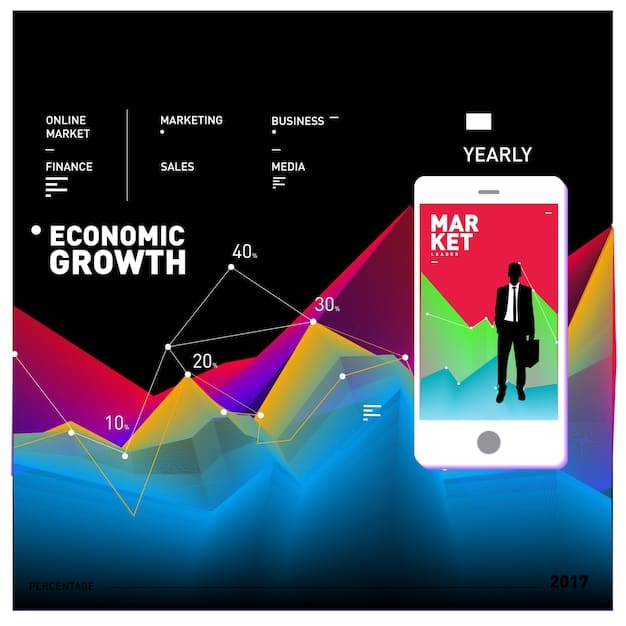Podcast Advertising Rates US 2025: Costs & Trends

Podcast advertising rates for a 30-second spot in the US are expected to vary widely in 2025, influenced by factors like audience size, niche, and ad placement, potentially ranging from \$500 to \$10,000 or more per episode.
Understanding podcast advertising rates: What to Expect to Pay for a 30-Second Spot on Popular US Podcasts in 2025 is crucial for advertisers looking to tap into the growing podcast market. As the popularity of podcasts continues to surge, knowing the costs associated with advertising can help you make informed decisions and optimize your marketing budget.
Understanding the Podcast Advertising Landscape in the US
The podcasting industry has experienced exponential growth over the past decade, becoming a powerful medium for content creators and advertisers alike. Understanding the complexities of this landscape is essential before diving into the specifics of advertising costs.
The Rise of Podcast Advertising
Podcast advertising has emerged as a highly effective marketing channel due to its targeted reach and engaged audience. Unlike traditional advertising methods, podcasts allow advertisers to connect with listeners who have a genuine interest in the content.
Podcast advertising offers a unique opportunity to reach niche audiences with tailored messaging. This level of precision can lead to higher conversion rates and a better return on investment for advertisers.

- Audience Engagement: Podcast listeners are typically more engaged and loyal than consumers of other media.
- Targeted Reach: Podcasts cater to specific interests, allowing advertisers to reach niche audiences effectively.
- Intimate Connection: The personal nature of podcasts fosters a sense of trust and connection between hosts and listeners.
The US podcast market is one of the largest and most dynamic globally, with a diverse range of content and a growing listener base. As the market matures, advertising rates are becoming more standardized, though still influenced by various factors.
Factors Influencing Podcast Advertising Rates
Several factors come into play when determining podcast advertising rates. These include audience size, niche, ad placement, and the podcast’s overall popularity. Understanding these elements can help advertisers negotiate better rates and choose opportunities that align with their goals.
Audience Size and Demographics
The number of listeners a podcast has directly impacts its advertising rates. Podcasts with larger audiences typically command higher fees because they offer greater reach.
Demographics also play a crucial role. Podcasts with a well-defined and desirable demographic (e.g., high-income professionals, tech enthusiasts) are often more attractive to advertisers.
Niche and Content Relevance
The niche of a podcast can significantly impact its advertising rates. Highly specialized podcasts that cater to specific interests often attract advertisers targeting those niches.
Content relevance is also key. Advertisements that align with the podcast’s content and resonate with its audience tend to perform better, making those spots more valuable.
- Audience Size: Larger audiences mean more potential customers for advertisers.
- Demographics: Specific demographics can make a podcast more attractive to certain brands.
- Content Relevance: Ads that fit the podcast’s theme are more likely to engage listeners.
Podcast advertising rates are not static; they evolve with the market. As more advertisers recognize the value of podcasting, demand for ad spots increases, affecting pricing.
Expected Podcast Advertising Rates in 2025
Forecasting specific podcast advertising rates for 2025 requires analyzing current trends and anticipating future market dynamics. While exact figures can vary, understanding the general range can help advertisers budget effectively.
CPM (Cost Per Mille) Model
The CPM model, or cost per thousand listeners, is a common pricing structure in podcast advertising. In 2025, CPM rates for a 30-second spot on popular US podcasts could range from \$20 to \$50.
CPM rates can vary depending on the podcast’s niche, audience demographics, and ad placement. Premium podcasts with highly engaged audiences may command higher CPMs.
Fixed Rate Model
Some podcasts offer a fixed rate for advertising spots, regardless of the number of listeners. This model can be advantageous for advertisers seeking predictability in their budgeting.
Fixed rates for a 30-second spot on popular US podcasts in 2025 could range from \$500 to \$10,000 or more per episode, depending on the podcast’s popularity and influence.

- CPM Rates: Expect to pay \$20-\$50 CPM for a 30-second spot on popular podcasts.
- Fixed Rates: Costs can range from \$500 to \$10,000+ per episode, depending on the podcast’s reach.
- Negotiation: Advertising rates are often negotiable, especially for long-term commitments.
The shift towards programmatic advertising in podcasting is expected to continue in 2025, potentially impacting advertising rates and making the process more data-driven and efficient.
Strategies for Negotiating Podcast Advertising Rates
Effective negotiation can significantly impact the cost of podcast advertising. Advertisers should employ various strategies to secure the best possible rates while maximizing their reach and impact.
Research and Benchmarking
Before entering negotiations, research average podcast advertising rates in similar niches and for podcasts with comparable audience sizes. This provides a baseline for your negotiations.
Benchmarking against industry standards and competitor rates can strengthen your position and help you justify your offers.
Long-Term Commitments
Offering a long-term commitment (e.g., a sponsorship for multiple episodes or seasons) can often result in lower rates. Podcasts value consistent revenue streams and may offer discounts in exchange for stability.
Consider bundling ad spots across multiple episodes or podcasts to negotiate a better overall rate.
Build a strong relationship with the podcast host or advertising team. Establishing a positive rapport can lead to more favorable terms and opportunities.
Measuring the ROI of Podcast Advertising
Determining the return on investment (ROI) of podcast advertising is crucial for justifying marketing spend and optimizing future campaigns. Advertisers should track key metrics to assess the effectiveness of their ads.
Key Performance Indicators (KPIs)
Identify key performance indicators (KPIs) such as website traffic, lead generation, conversion rates, and brand awareness. These metrics provide tangible evidence of your advertising impact.
Use tracking pixels and unique promo codes to monitor website traffic and conversions from podcast listeners.
Attribution Models
Implement attribution models to understand how podcast advertising contributes to the overall customer journey. This helps determine the true value of your investment.
Consider using surveys and listener feedback to gather qualitative data on the impact of your ads on brand perception and purchasing decisions.
Regularly analyze your podcast advertising performance and adjust your strategy based on the data. This ensures you are maximizing your ROI and achieving your marketing goals.
The Future of Podcast Advertising in the US
The podcast advertising landscape is continuously evolving, with new technologies and trends shaping its future. Understanding these developments can help advertisers stay ahead of the curve and capitalize on emerging opportunities.
Technological Advancements
Advancements in ad tech, such as dynamic ad insertion and programmatic advertising, are making podcast advertising more targeted and efficient. These technologies allow for real-time optimization and personalized messaging.
Artificial intelligence (AI) is playing an increasing role in podcast advertising, enabling better audience targeting, ad creative optimization, and performance tracking.
The rise of interactive podcast ads, such as polls and quizzes, is creating more engaging experiences for listeners and providing advertisers with valuable data.
Key Takeaways
In conclusion, navigating the world of podcast advertising rates in 2025 requires a keen understanding of market dynamics, negotiation tactics, and measurement strategies. Advertisers who stay informed and adapt to evolving trends will be best positioned to succeed in this dynamic medium.
| Key Point | Brief Description |
|---|---|
| 💰 Advertising Rates | Vary based on audience size, niche, and placement. |
| 🎯 Targeted Reach | Podcast ads reach specific niches effectively. |
| 📈 Market Growth | Podcast ad spend is projected to keep growing. |
| 🤝 Negotiation | Long-term commitments can lower ad rates. |
Frequently Asked Questions
▼
The average CPM (cost per mille) for podcast ads in 2025 can range from $20 to $50, depending on the podcast’s audience size, niche, and ad placement. Premium podcasts with highly engaged audiences may command higher CPMs.
▼
To negotiate lower podcast advertising rates, research average rates in similar niches, offer long-term commitments, bundle ad spots, and build strong relationships with podcast hosts or advertising teams.
▼
Key metrics to measure podcast advertising ROI include website traffic, lead generation, conversion rates, and brand awareness. Use tracking pixels, unique promo codes, and attribution models to monitor these metrics.
▼
Technology is changing podcast advertising through dynamic ad insertion, programmatic advertising, AI-driven optimization, and interactive ad formats. These advancements enable more targeted, efficient, and engaging advertising experiences.
▼
Fixed rates for a 30-second spot on popular US podcasts in 2025 could range from \$500 to \$10,000 or more per episode, depending on factors. This model can be advantageous for advertisers seeking predictability.
Conclusion
Understanding podcast advertising rates: What to Expect to Pay for a 30-Second Spot on Popular US Podcasts in 2025 requires a blend of market knowledge, negotiation skills, and analytical acumen. By staying informed about industry trends and employing effective strategies, advertisers can maximize their ROI and tap into the unique potential of podcast advertising.





